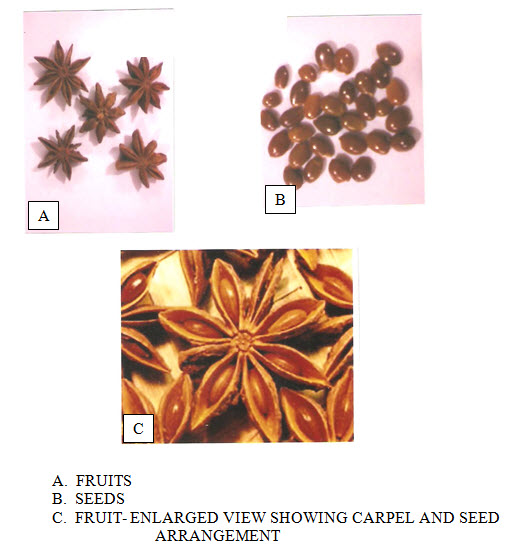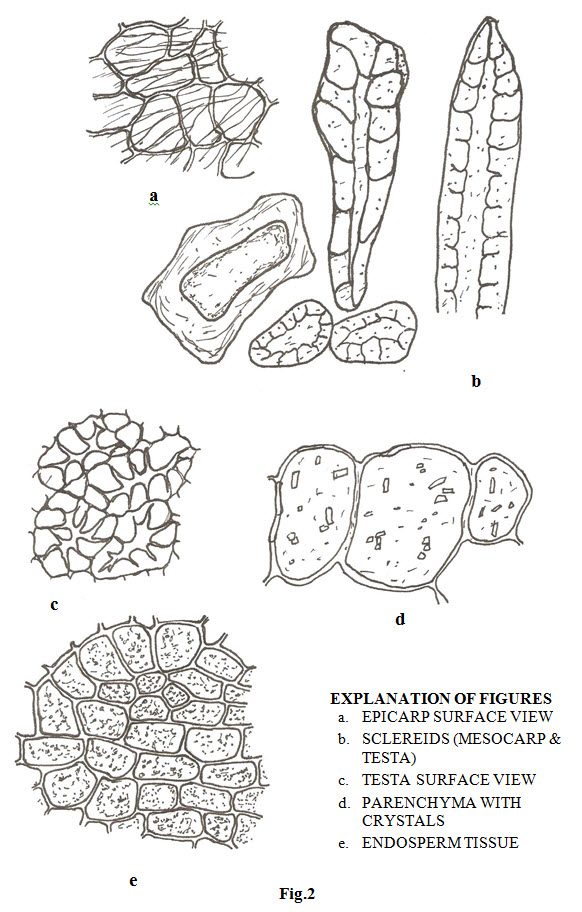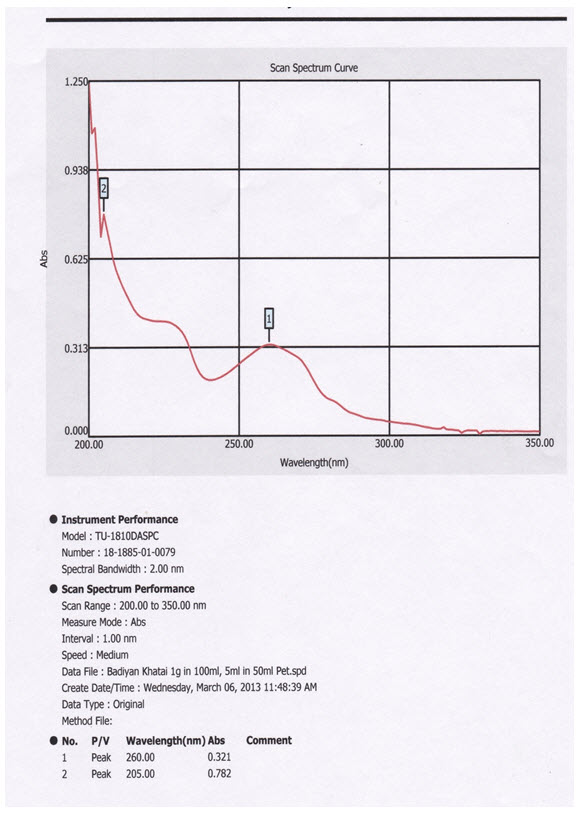{ DOWNLOAD AS PDF }
 ABOUT AUTHORS
ABOUT AUTHORS
M. A. Rashid*, R. H. Zuberi
Pharmacognosy Section
Regional Research Institute of Unani Medicine (RRIUM),
Aligarh, UP, India
* marashid212@gmail.com
ABSTRACT
The fruit of Illicium verum Hook. f. of family Magnoliaceae has been utilized therapeutically as medicine as well as a spice. It is used to relieve a number of human ailments, owing to its properties as carminative, stimulant and appetizer. In order to set the quality standards, the market sample of the drug has been identified and standardized on the basis of Pharmacopoeial parameters, such as salient macro and microscopic characters, ash values, solubility, successive extractive values, thin layer chromatographic evaluations and U.V. spectroscopic analysis. Besides qualitative and quantitative estimations, fluorescence analysis of powdered drug has also been carried out in order to set standards for the crude drug.
[adsense:336x280:8701650588]
REFERENCE ID: PHARMATUTOR-ART-2425
|
PharmaTutor (Print-ISSN: 2394 - 6679; e-ISSN: 2347 - 7881) Volume 4, Issue 8 Received On: 10/03/2016; Accepted On: 21/03/2016; Published On: 01/08/2016 How to cite this article: MA Rashid, RH Zuberi; Pharmacognostical studies for standardisation of a medicinal spice, the fruit of Illicium Verum hook.f.; PharmaTutor; 2016; 4(8); 36-41 |
INTRODUCTION
The fruit is known as Anasphal and Phool Chakri in Hindi, Raziyanaj-e khatai in Arabic, and popular as star anise in English[1]. It has an agreeable, aromatic sweet taste and a pleasant odour resembling Anise (Pimpenella anisum Linn.). It is used as a condiment for flavouring curries, confectionaries and also for pickling. It is chewed to sweeten the breath and helps digestion. The fruits are stomachic, carminative, expectorant and deodorant, useful in dyspepsia, flatulence, spasmodic colonalgia, dysentery, cough, asthma, rheumatism, hemiplegia, facial paralysis and halitosis.[1,2] It is considered to possess a special action on the bronchial mucous surface.[4,5,6] It is described in Unani system of medicine as an effective remedy for indigestion, flatulence, constipation and intestinal inflammation and obstruction.[7,8]
It also yields an essential oil which is stimulant, expectorant and diuretic. It relieves colic and employed as an application in rheumatism and around the ears in otalgia, and also as an antiseptic.[5]
A survey of literature on the phytochemical studies revealed that the fruit of Illicium verum contains b-sitosterol, alpha and beta pinene, b-myrcene, a-phellandrene, car-3-ene, p-cymene, limonene, cineol, 4(10)-thujene, linalool, 4-terpineol, a-terpineol, cis-anethole, anisaldehyde, trans-anethole. Safrole and ethyl ether of hydroquinone have also been detected. The fatty acid composition contains myristic, palmatic, stearic and linoleic acids. It also contains copaene, anisketone, sesquicitronellene, caryophyllene, farnesene, methyl-3-methoxy-benzoate, methylisoeugenol, nerolidol, m-methoxy-a-benzylbenzene acetic acid, p-hydroxybenzoic acid.[1,9,10]
Further, review of the available published work on the drug indicated that no thorough work on standardization of this important drug has been reported. The present pharmacopoeial standardization work was therefore carried out to evolve the quality standards to determine correct identity and quality of the drug.
MATERIALS AND METHODS
The fruits were procured from Bangalore and botanically identified in the Pharmacognosy section of RRIUM, Aligarh. The drug was studied for salient morphological features and the powder was used for microscopic study and other quality standard parameters, like solubility in ethanol and water, ash values, successive extractive values, pH of 1% and 10% aqueous solutions and thin layer chromatography.[11,12,13] The figures were obtained using camera lucida and measured through standardized eye piece and stage micrometer. Successive extractive values of the drug were carried out using a soxhlet apparatus with different solvents like petroleum ether (60-80o), benzene, acetone, dichloromethane, chloroform, ethyl alcohol and water respectively.[11,12] Fluorescence studies were carried out with powdered drug, after treatment with different chemical reagents.[14]
Thin Layer Chromatography:
The powdered drug (3 g) was soaked in methanol (30 ml) in a conical flask with stopper (100 ml) and was kept overnight for complete digestion. The material was refluxed on a water bath for 15 minutes, cooled and filtered through Whatman No. 1 filter paper circles, the filtrate so obtained was reduced under vaccum till semi dryness, diluted with methanol and used for TLC spotting.[13,15] Ascending chromatography technique was used to separate the phytochemical contents on Aluminium pre coated plates of silica gel 60 F254 (Emerck, thickness 0.20 mm), after chamber saturation for 30 minutes. The extracted drug sample was spotted on TLC plates and developed with Hexane-ethyl acetate formic acid (7:3:1) v/v as solvent system.
After the development, the TLC plates were completely air dried and detected under UV (365 nm) radiation, and after the spray treatment with 10% ethanolic-H2SO4 reagent and heating the chromatogram at 110oC till optimum spot development. The chromatogram was exposed to iodine vapours. Another freshly developed plate was sprayed with vanillin-H2SO4 reagent and heated at 110oC till coloured spots appeared. The reading for each spot was noted, Rf values calculated and their respective colour zones were recorded.
U.V. Spectroscopy:
1.0 g. of powdered drug was extracted in 100 ml. petroleum ether (60-800) and 05 ml. of this solution was diluted to 50 ml with petroleum ether (60-800) in a volumetric flask which was used to obtain U.V. spectrum.
[adsense:468x15:2204050025]
OBSERVATIONS AND RESULT
Macroscopic characters:
The drug consists of dried fruit which is an etaerio of follicles, eight in number, attached to a central axis by their bases, radiating horizontally. Each follicle is about 1.5 cm long, boat shaped, reddish brown, woody, slightly wrinkled externally, smooth and glossy from inside, bluntly beaked at the apex. The follicles are split open, showing single seed which is reddish brown, hard, shinning in appearance. It has an aromatic, pleasant odour resembling anise and a sweetish taste (Fig. 1).
The powder of star anise is dark reddish-brown, oily in appearance having a pleasant, aromatic characteristic odour and slightly sweet characteristic taste.
Microscopic characters:
The epicarp in surface view shows brown polygonal slightly thick walled cells with striated cuticle (Fig. 2.a). The powder shows abundant sclereids of various shapes and sizes with varying degree of thickening and pitting of the walls. The largest group of sclereids comprises much elongated fibrous sclereids having thick striated walls with simple pits (Fig. 2.b). Crystals of calcium oxalate and oil globules are also conspicuous. The testa in surface view shows characteristic polygonal sclerenchyma having sinuous walls with lumen appearing irregularly branched due to abundant pitting (Fig.2.c). Parenchyma having rhomboid/rectangular crystals of calcium oxalate and endosperm tissue consisting of polygonal cells with slightly thickened walls are also prominent (Fig. 2.d, 2.e).

Fig.1
NOW YOU CAN ALSO PUBLISH YOUR ARTICLE ONLINE.
SUBMIT YOUR ARTICLE/PROJECT AT editor-in-chief@pharmatutor.org
Subscribe to Pharmatutor Alerts by Email
FIND OUT MORE ARTICLES AT OUR DATABASE

Physico-chemical Studies:
The results of physico-chemical quality parameters have been embodied in Table 1 & 2.
Table 1. Physico-chemical Quality Standards
|
Parameters |
Values |
Mean |
Range |
|
Solubility (%, w/v) |
|||
|
(i) Alcohol (95%) |
3.079, 3.084, 3.081 |
3.081 |
3.079 – 3.084 |
|
(ii) Hexane |
1.588, 1.584, 1.582 |
1.582 |
1.582 – 1.588 |
|
(iii) Water |
4.136, 4.132, 4.134 |
4.134 |
4.132 – 4.136 |
|
Ash values (%, w/w) |
|||
|
(i) Total Ash |
3.027, 3.031, 3.029 |
3.029 |
3.027 – 3.029 |
|
(ii) Acid Insoluble Ash |
1.937, 1.940, 1.942 |
1.939 |
1.937 – 1.942 |
|
(iii) Water Soluble Ash |
0.893, 0.895, 0.891 |
0.893 |
0.891 – 0.895 |
|
pH values |
|||
|
1% aqueous solution |
4.54, 4.52, 4.58 |
4.54 |
4.54 – 4.58 |
|
10% aqueous solution |
4.19, 4.20, 4.22 |
4.20 |
4.19 – 4.22 |
|
Moisture contents (%, w/w) |
|||
|
Loss on drying at 105oC |
5.94, 5.89, 5.87 |
5.90 |
5.87 – 5.90 |
Table 2. Successive Extractive Values
|
Extractive solvents |
Successive values (%, w/w) |
Mean value |
Range |
|
Petroleum Ether (60-80o) |
7.82, 7.76, 7.73 |
7.77 |
7.73 – 7.82 |
|
Benzene |
0.81, 0.85, 0.88 |
0.83 |
0.81 – 0.88 |
|
Acetone |
12.76, 12.80, 12.72 |
12.76 |
12.72 – 12.80 |
|
Dichloromethane |
0.126, 0.122, 0.118 |
0.122 |
0.118 – 0.126 |
|
Ethanol |
4.62, 4.57, 4.65 |
4.61 |
4.57 – 4.65 |
|
Water |
29.78, 29.72, 29.82 |
29.77 |
29.72 – 29.82 |
Thin Layer Chromatography:
Results of TLC have been summarized in Table 3.Thin layer chromatogram did not exhibit any notable spot in visible light. Under UV radiation it exhibited six fluorescent spots. After spray treatment with Vanilline-H2SO4 reagent, eight spots appeared; on exposure to Iodine vapours six spots were seen and on spraying with 10% Ethanolic H2SO4 reagent, seven spots were observed. (Fig. 3)
Table 3. Thin Layer Chromatography of Methanolic Extract of fruit of Illicium verum
|
Extracts |
Detection/ Spray treatment |
No. of spots |
Rf values |
|
Methanol |
UV (365 nm) |
6 |
0.17 (dull violet brown), 0.30 (indigo violet), 0.33, 0.34 (indigo brown), 0.58 (light violet), 0.63 (dull brown) |
|
On exposure to I2 vapours |
6 |
0.16 (light brown), 0.23 (dark brown), 0.35 (light brown), 0.57 (brown), 0.64 (light yellowish brown), 0.76 (brown) |
|
|
Derivatized with 10% Ethanolic-H2SO4 reagent and heating at 110oC |
7 |
0.19 (light gray), 0.51 (light pinkish gray), 0.64 (dull gray), 0.73 (light pinkish brown), 0.76 (light pink), 0.83 (light bluish gray), 0.96 (dull pinkish brown) |
|
|
Derivatized with vanillin H2SO4 reagent and heating at 110oC |
8 |
0.13 (light orange blue), 0.33, 0.41 (blue), 0.54 (dark brown), 0.64 (violet blue), 0.70 (light pinkish brown), 0.77 (violet blue), 0.84 (orange brown) |
U.V. Spectroscopy:
U.V. spectrum gave two peaks at wave length 260 and 205 nm at absorbance of 0.321 and 0.782 respectively. (Fig. 4)

Fig.3 TLC CHROMATOGRAMS- Fruit extract of Illicium verum

Figure 4. UV SPECTRUM-Fruit extract of Illicium verum
Fluorescence Analysis:
Behavior of powdered drug with different chemical reagents in day light as the degree of change after reaction with the respective reagent and also their fluorescence behavior under UV (365 nm) radiation are recorded in Table-4.
Table 4. Fluorescence Analysis of powdered fruit of Illicium verum with different chemical reagents
|
S.No. |
Chemical Reagents |
Observations |
|
|
Day Light |
UV (366 nm) |
||
|
1. |
Conc. Sulphuric acid |
Dark brown |
Black |
|
2. |
Conc. Hydrochloric acid |
Dull brown |
Blackish brown |
|
3. |
Conc. Nitric acid |
Dark brown |
Bluish black |
|
4. |
Iodine solution (2% in Ethanol) |
Dark brown |
Dark bluish black |
|
5. |
Vanillin H2SO4 reagent |
Light brown |
Bluish brown |
|
6. |
Biurette Reagent |
Light bluish brown |
Dark brown |
|
7. |
H2SO4 (10% in Methanol) |
Brown |
Dull dark brown |
|
8. |
Ferric chloride reagent (5% aqueous soln.) |
Light yellowish brown |
Dark golden brown |
|
9. |
Acetic acid |
Light grown |
Bluish black |
|
10. |
Picric acid soln. (saturated) |
Yellowish brown |
Violet blue |
|
11. |
Orthophosphoric acid |
Brown |
Dark bluish brown |
|
12. |
Drug as such |
Golden brown |
Dark brown |
CONCLUSION
The present standardization studies based on pharmacopoeial parameters such as macroscopic and microscopic characters, physico-chemical parameters, fluorescence analysis, UV spectrum and TLC profile have provide sufficient characters, specific to the drug which will help in providing standards for quality control and quality assurance related to the fruit of Illicium verum. Salient morphological characters include boat shaped, woody, single seeded follicles attached to a central axis, giving a star shaped appearance; seeds smooth shining, reddish brown; the material having strong aromatic characteristic odour. Salient microscopic characters observed in the powder comprise elongated sclereids with thick striated walls and simple pits; rhomboid/rectangular crystals of calcium oxalate and endosperm tissue consisting of polygonal cells with slightly thickened walls having abundant oil globules.
The study assumes great significance as the results will facilitate identification of genuine material and detection of adulterants in the drug available commercially.
Acknowledgement: The authors are highly indebted to the Director General, CCRUM, New Delhi for providing necessary research facilities and constant encouragement.
REFERENCES
1. Anonymous; The wealth of India–Raw Materials; National Institute of Science Communication and Information Resources, New Delhi; 2001; Vol. V;166-167.
2. Anonymous; Indian Medicinal Plants–A compendium of 500 species; Orient Longman Limited, Hyderabad; 1995; vol. 3; 206.
3. Ahmad, F., Nizami, Q. and Aslam, M.; Classification of Unani Drugs with English and Scientific Names; Maktaba Eshat-ul-Quran, Delhi; 2005; 30.
4. Wallis, T.E.; A Text Book of Pharmacognosy, J & A, Churchill Ltd. London; 1967; 279-280.
5. Puri, H.S.; Phytochemical screening of the plants of silent valley-I; Bulletin of Medico Ethnobotanical Research 1;1980; 384-392.
6. Tariq, N.A.; Taj-ul Mufridat, Idara Kitab-ush-shifa, New Delhi; 2004; 117.
7. Ghani, N.; Khazinat ul-Advia, Idara Kitab-ush-Shifa, Delhi; 1933; 325.
8. Kabiruddin, M.; Makhzan-ul-Mufridat, Idara Kitab-ush-Shifa, New Delhi; 2007; 97.
9. Rastogi, R.P. and Mehrotra, B.N. Compendium of Indian Medicinal Plants. Central Drug Research Institute Lucknow and Publication and Information Directorate, CSIR, New Delhi; vol. 3; 1995; 357.
10. Asolkar, L.V.; Kakkar, K.K. and Chakre, O.J. Glossary of Indian Medicinal Plants with Active Principles. Publication and Information Directorate, CSIR, New Delhi; 1992; 366.
11. Anonymous; Quality Control Methods for Ayurveda, Siddha and Unani Medicine, Department of AYUSH, Govt. of India, New Delhi; 1998; 28, 29, 35, 36.
12. Anonymous; Quality Control Methods for Medicinal Plant Materials. World Health Organization, Geneva; 1998; 25-30.
13. Genkins, G.L., Knevel, A.M. and Digangi, F.E.; Quantitative Pharmaceutical Chemistry. The McGraw Hill Book Company Limited, London; 1967; 251-253.
14. Chase, C.R. and Pratt, R.J.; Fluorescence of powdered vegetable drugs with particular reference to the development of a system of identification. J. Am. Pharm. Assoc., 1949; 38; 324-331.
15. Stahl, E.; Thin layer chromatography – A Laboratory Handbook, Springer Verlag, Berlin, Germany; 1969; 210-216.
NOW YOU CAN ALSO PUBLISH YOUR ARTICLE ONLINE.
SUBMIT YOUR ARTICLE/PROJECT AT editor-in-chief@pharmatutor.org
Subscribe to Pharmatutor Alerts by Email
FIND OUT MORE ARTICLES AT OUR DATABASE









